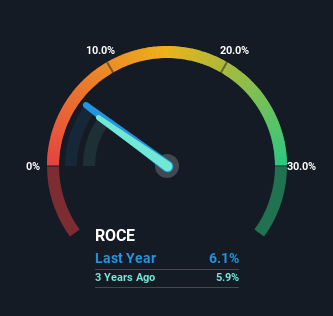Austevoll Seafood (OB:AUSS) Is Reinvesting At Lower Rates Of Return
What are the early trends we should look for to identify a stock that could multiply in value over the long term? Ideally, a business will show two trends; firstly a growing return on capital employed (ROCE) and secondly, an increasing amount of capital employed. If you see this, it typically means it's a company with a great business model and plenty of profitable reinvestment opportunities. In light of that, when we looked at Austevoll Seafood (OB:AUSS) and its ROCE trend, we weren't exactly thrilled.
Understanding Return On Capital Employed (ROCE)
For those who don't know, ROCE is a measure of a company's yearly pre-tax profit (its return), relative to the capital employed in the business. To calculate this metric for Austevoll Seafood, this is the formula:
Return on Capital Employed = Earnings Before Interest and Tax (EBIT) ÷ (Total Assets - Current Liabilities)
0.061 = kr2.8b ÷ (kr54b - kr7.7b) (Based on the trailing twelve months to March 2024).
Thus, Austevoll Seafood has an ROCE of 6.1%. On its own, that's a low figure but it's around the 6.9% average generated by the Food industry.
Check out our latest analysis for Austevoll Seafood

In the above chart we have measured Austevoll Seafood's prior ROCE against its prior performance, but the future is arguably more important. If you'd like to see what analysts are forecasting going forward, you should check out our free analyst report for Austevoll Seafood .
What The Trend Of ROCE Can Tell Us
When we looked at the ROCE trend at Austevoll Seafood, we didn't gain much confidence. To be more specific, ROCE has fallen from 9.6% over the last five years. On the other hand, the company has been employing more capital without a corresponding improvement in sales in the last year, which could suggest these investments are longer term plays. It may take some time before the company starts to see any change in earnings from these investments.
Our Take On Austevoll Seafood's ROCE
Bringing it all together, while we're somewhat encouraged by Austevoll Seafood's reinvestment in its own business, we're aware that returns are shrinking. Unsurprisingly, the stock has only gained 9.5% over the last five years, which potentially indicates that investors are accounting for this going forward. Therefore, if you're looking for a multi-bagger, we'd propose looking at other options.
One more thing, we've spotted 2 warning signs facing Austevoll Seafood that you might find interesting.
If you want to search for solid companies with great earnings, check out this free list of companies with good balance sheets and impressive returns on equity.
New: Manage All Your Stock Portfolios in One Place
We've created the ultimate portfolio companion for stock investors, and it's free.
• Connect an unlimited number of Portfolios and see your total in one currency
• Be alerted to new Warning Signs or Risks via email or mobile
• Track the Fair Value of your stocks
Have feedback on this article? Concerned about the content? Get in touch with us directly. Alternatively, email editorial-team (at) simplywallst.com.
This article by Simply Wall St is general in nature. We provide commentary based on historical data and analyst forecasts only using an unbiased methodology and our articles are not intended to be financial advice. It does not constitute a recommendation to buy or sell any stock, and does not take account of your objectives, or your financial situation. We aim to bring you long-term focused analysis driven by fundamental data. Note that our analysis may not factor in the latest price-sensitive company announcements or qualitative material. Simply Wall St has no position in any stocks mentioned.
Have feedback on this article? Concerned about the content? Get in touch with us directly. Alternatively, email editorial-team@simplywallst.com
About OB:AUSS
Austevoll Seafood
A seafood company, produces and sells salmon and trout, whitefish, and pelagic in Norway, the European Union, the United Kingdom, Eastern Europe, Africa, North America, Asia, and South America.
Very undervalued with reasonable growth potential.
Market Insights
Community Narratives




